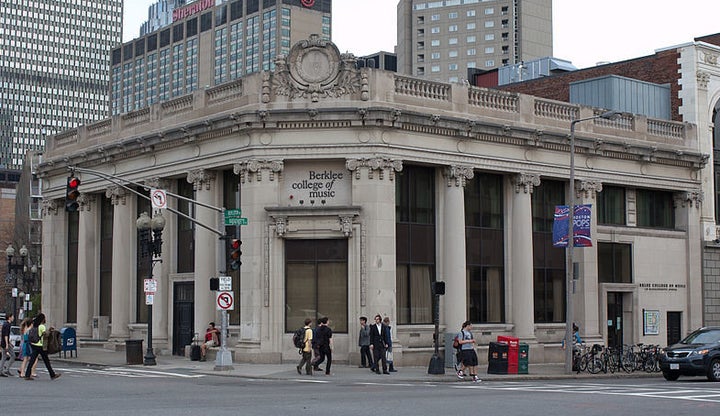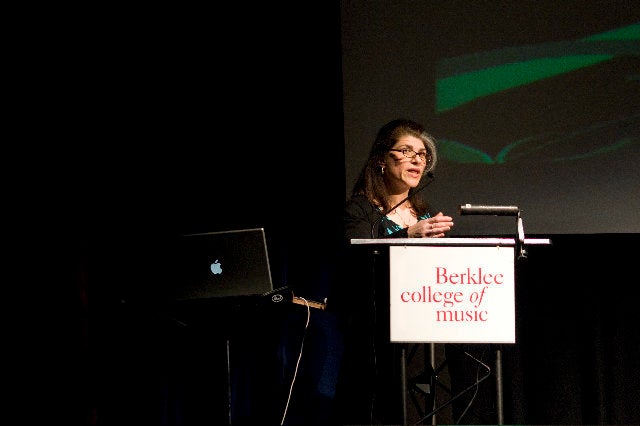
Berklee College of Music, located in Boston’s Back Bay neighborhood, is one of the world’s largest schools for aspiring singers, producers, songwriters, music therapists and film scorers. Each of its roughly 4,500 students, in one way or another, focuses on the idea of performance -- on the stage, in the recording studio and in everyday life.
Four years ago, cultural studies professor Lori Landay was inspired to take that idea of performing and dig deeper into it, designing an annual seminar-style course called “What is Being?” Each spring, 12 students join Landay on campus, attend arts performances in the city, and read novels and philosophy texts to try to understand what it means for humans to exist and thrive. (The course is not being offered this year because Landay is on sabbatical.)
Landay, whose own research focuses on visual culture and interactive media, spoke with The Huffington Post about what it means to work with artists to explore the big questions.
“I started pondering what that meant for my students — as individuals, as performers, and in an age when there is so much emphasis on seeming in celebrity culture and through our use of the media.”
How did this class come to be?
The course came about because there were posters around Berklee with the college motto, "to be, not to seem," and I started pondering what that meant for my students -- as individuals, as performers, and in an age when there is so much emphasis on seeming in celebrity culture and through our use of the media. When I was developing the course to apply for the National Endowment for the Humanities "enduring questions" grant that made it possible, the question evolved: What does it mean to be? What is being?What does it mean to be? What is being?
In many ways, it’s my favorite course to teach. The narrative that I weave in it -- of how people ask the same questions in different ways, why those ways are different, and how the different answers others have found can help us form our own answers -- is a challenging and exciting stretch for me each time. Seeing what the students make in their multimedia projects is the great reward for my effort.
How do you define "being"? How do students? Is there even an answer?
There are a lot of answers! But not a sole answer that the course offers. Each student comes in with some perception of what being is, and they each leave better able to articulate their individual answer to the question of what is being, and a much stronger sense of what that question means.

The goals of the course include giving students the tools to form questions, seek information, articulate their ideas in the contexts of what others have thought, and discuss them with others. We encounter many different definitions of being in the course, from different thinkers and artists, disciplinary perspectives, cultures and time periods.
The central question leads to subquestions that shape the semester: Is it better to be, rather than to seem? Or is performance being or seeming? Or what is being in contemporary culture when images and illusions are so prevalent? Those subquestions connect our inquiry into being to our everyday lives and experiences.
What’s been the reaction from students?
I've noticed how the students have grown into posing big questions and thinking deeply about them. At first, there’s almost an embarrassment about it. "Whoa, that’s deep!" they say, shaking it off, or hedging a terrific insight with, "I’m probably reading too much into this, but..." By the end, that hedging is over, and they are engaging with the thinkers and artists, putting their ideas in the contexts of those of Plato, Machiavelli, Erving Goffman, Nella Larsen, Marina Abramović, Terry Gilliam or Philip K. Dick, and discussing with their classmates.
The other big change I love to see is that they leave the course with a much stronger sense of a historical perspective. On the first day, when we read the source of the college motto -- Cicero’s "On Friendship" -- and find that Cicero was talking about flattery, students quickly connect to "friendship" on social media platforms like Facebook, and how seeming is emphasized over being. It’s a great discussion every time, but it’s like nothing has changed between Cicero’s era and ours.
“What I tell students is that while we can only we dip into something, they have the rest of their lives to read, see, or listen to the rest.”
By the end of the course, they understand that what Cervantes, Shakespeare, Edward Hopper, Heidegger or Tibetan monks creating a mandala out of sand, expressed about being was shaped by their worldview, just as their perspective is. We cover a lot of territory in the course through the lens of the central questions, but what I tell students is that while we can only we dip into something, they have the rest of their lives to read, see or listen to the rest.
Why’s being so important to study, especially at a place like Berklee where students focus on music?
It’s an important area for students to study because everyone, whether they are specializing in music or anything else, asks the "enduring" questions. The questions endure for a reason -- they are part of what defines us as human, and they connect us to the past, to others in the present, and to the future. By learning how people have explored the biggest questions in cultural expressions like art, literature, film, music and dance, we give students concepts, characters, themes and images that will help them as they inevitably ask the big questions in their lives. By thinking through how others have posed and answered questions in philosophy, sociology, science and religious studies, students gain models to use in forming their own ideas. That will only make them stronger musicians, citizens, friends and people.
“It’s important for students to have time to focus only on the big question so they can get past the tendency that’s prevalent in our culture to stay on the surface.”
It’s important for students to have time to focus only on the big question so they can get past the tendency that’s prevalent in our culture to stay on the surface and have a forum in which to think deeply about serious issues. They are really interested in the big questions and eager, once you show them how, to develop and express their ideas.
What’s been the biggest moment of teaching "What is Being"?
The authenticity, creativity, and clarity of some of the student projects has moved me tremendously.
The biggest highlight for me was when Bobby McFerrin, who was on campus as a visiting artist, came to the class. McFerrin explained that when he is on stage, he is not "performing," but "being," and this made for a great discussion, with the students telling him some of what we’d been doing in the class.
He shared with them his story, how he made a conscious decision to choose authenticity. It was fantastic interaction, and I felt privileged to sit in a circle with him and the 12 students. We had other great guests, too, like the bassist/composer/producer/educator John Clayton, the photographer Henry Diltz, who shot so many iconic rock images like the Morrison Hotel Doors album cover, and slam poet Caroline Harvey.
The more I think about the course, the more I can’t wait until I teach it again.
This interview has been edited for clarity and length.
